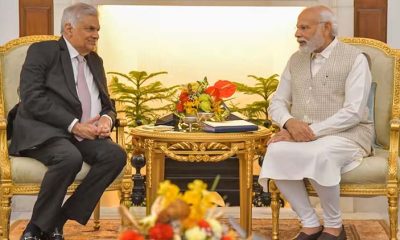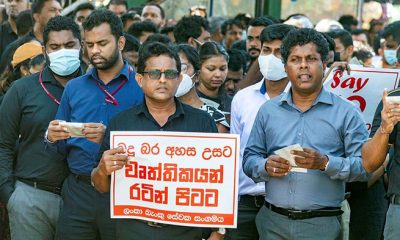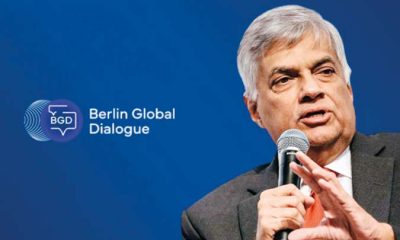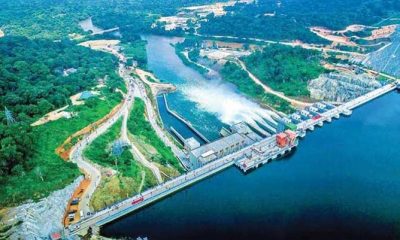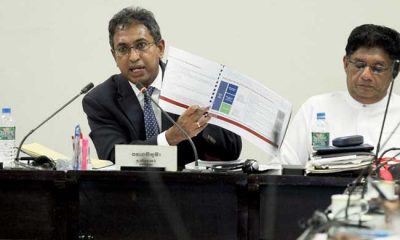Features
Experimenting with State-Owned Enterprises
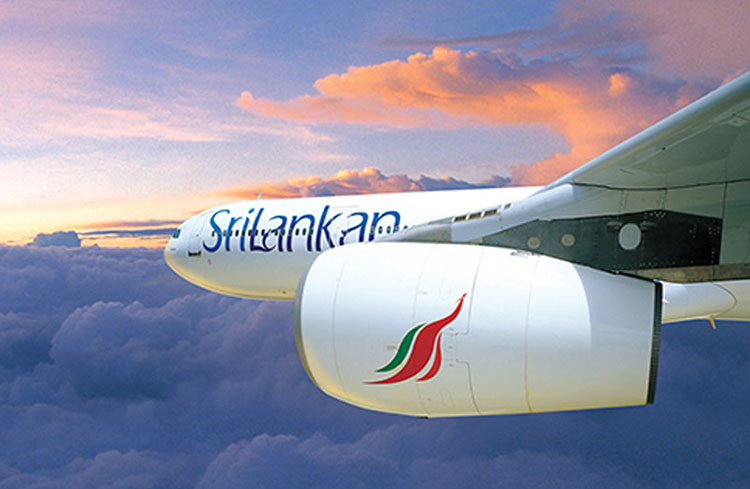
by Neville Ladduwahetty
The total number of Sri Lanka’s State-Owned Enterprises (SOEs) is reported to be 527. Of these, 55 are categorized as strategically important. According to Public Finance Data and Analysis, only 11 out of 52 SOEs have Published Financial Data up to 2022. Consequently, except for the common knowledge that the overwhelming majority of SOEs are loss making institutions, no one has a clue as to the extent of the cumulative losses incurred, nor the number employed by the SOEs.
Against this background, the public has raised concern about the privatization of the SOEs, especially the strategically important ones. The government has appointed Suresh Shah as the Head of State-Owned Enterprises Restructuring Unit (SOERU) to review and address issues relating to SOEs.
During a seminar held at the Organization of Professional Associations (OPA), Shah reportedly said: ‘To ensure transparency and effective management, the draft legislation is based on nine guiding principles stipulated in the Cabinet-approved SOE reform policy, covering board appointments, policies, financial aspects and others. Around 85 SOEs have been identified as commercial entities, out of 138 considered’.
What happens to the rest? According to Shah ‘A key highlight of the upcoming legislation is to bring SOEs under a Holding Company (HoCo) which would drive comprehensive reforms of state enterprises, the management and governance of state enterprises, and state’s portfolio of enterprises. The proposed HoCo is modelled after Singapore’s Temasek. However, it would take time and effort for this entity to evolve into modern day Temasek’ (Mirror Business, February 02, 2024).
HISTORY of Sri LANKA’s SOEs
Since Independence, the public has heard ad nauseam, words such as “transparency and effective management”. Some include “accountability” as well. The fact that the draft legislation is based on “nine guiding principles” is no assurance that the HoCo would be free to live by them without interference of one kind or another. Before addressing reforms, it is necessary to understand WHY SOEs are in the state they are in today.
SOEs are used as vehicles to practise unabated nepotism that permits the appointment of the kith and kin of politicians to the Boards of SOEs and to give employment to political loyalists for favours done during elections. Consequently, most SOEs are compelled to carry the baggage of incompetent managers who are clueless to manage a bloated workforce. It is this reality that makes SOEs loss-making institutions from the very outset. Even profit making SOEs have to cater to the behest of their political masters.
For instance, SriLankan Airlines, which was a profitable institution under an effective management, began to incur losses after the removal of key personnel because they opted to cater to the obligations of their customers in preference to the convenience of those who appointed them. Similarly, the Chairman of SLT, who ran that institution profitably, was removed, without any explanation, and a new board appointed. A request was made to them to withdraw the case they had filed against the proposed merger between Dialog Axiata and Airtel. The refusal to oblige resulted in the board being asked to resign. A new board has now been appointed.
This is the culture in which the HoCo with its ‘nine guiding principles stipulated in the Cabinet approved SOE reform policy’ would have to operate. It is a far cry from the culture in Singapore, where Temasek operates. Does the fact that only around 85 have been identified as commercial entities mean that the remaining 442, out of the total of 527 SOEs, are allowed to hang out to dry as loss-making entities because the prospect of their survival under the HoCo is remote.
Therefore, instead of limiting the scope to SOEs with commercial value, a serious attempt should be made by the SOERU to develop a strategy to make the SOEs a collective mix of profitable and loss-making entities for the service they provide so that taken as a collective, SOEs are not a burden to the State. Instead of such an approach, the objective of the SOERU appears to be to identify those that could be attractive to the private sector because of their commercial value.
In this regard, policies adopted by the private actor could go beyond the limits of commercial valuations, to others, such as Security. For instance, the attempt to sell the government’s share in Sri Lanka Telecom to either of the two shortlisted companies of Indian and Chinese origins may not only have foreign policy implications but also cause security concerns as well.
PROPOSED REFORMS for SOEs
In addition to the intended reforms proposed by SOERU at the OPA seminar, the Secretary to the Ministry of Finance has said that one of the key legislations the government is working on relates to the SOE reform Bill. What is interesting is that both the Secretary and the SOERU representative emphasised the importance of transparent procedures in the selection of Members to the Boards of SOEs. While it is indeed heartening to hear the importance given to transparency in selecting Board Members with the right credentials, history tells us that however right the credentials are, there is no guarantee that the policies they opt for would turn out to be relevant to meet the ever-changing challenges.
Instances of this kind of mismatch abound. We have had individuals with outstanding credentials in economics who advocated lowering taxes and printing money with consequences, the likes of which Sri Lanka had not experienced. Perhaps, their policies may have been right under different circumstances, but they certainly did not prove right for the economic circumstances Sri Lanka was in when they were proposed. There were others who advocated banning the import of chemical fertiliser and replacing it with compost.
They did not realise that the high yield seed paddy that was used by the farmers not only increased their incomes but also enabled the State to feed the nation which depended on the use of chemical fertiliser. Furthermore, a fact recognised by agricultural research scientists is that high yield seed paddy is not compatible with compost because of low yields. Another is the instance where a highly placed bureaucrat advocated the import of urea because it was cheaper than producing it locally, and called for the dismantling and selling the urea plant. Soon afterwards, the sale prices of imported urea increased.
PROPOSED STRATEGY
The lesson to be learnt from the few experiences cited above is that while it is important to select the right Members for the Boards of SOEs, it is equally or even more important that they adopt the right policies. Since the reason for the failure of most SOEs is fundamentally one of poor or bad management resulting from the reasons cited above, it is absolutely vital that each SOE operates under agreed guidelines that are monitored regularly by the Oversight Committees of Parliament. Furthermore, since policies need to change with changing circumstances and challenges, structural arrangements that permit regular reviews are an absolute necessity.
The following procedures are recommended to ensure that each of the 527 SOEs function and perform under the close scrutiny of Parliament:
* NO SOE should be privatised, whether they have commercial value or not. 85 of the SOEs with commercial value are invariably located on prime land. Privatising such SOEs would tempt investors to sell such lands and gain healthy returns with no regard to the contributions made to the state from their operations and the personnel employed by them.
* Each SOE should be assigned to a particular Oversight Committee of Parliament.
* Each Oversight Committee should call upon SOEs assigned to them to submit a comprehensive Policy Statement with the participation of the workforce outlining the strategies they plan to adopt to realise their objectives.
* These policy statements should be reviewed by each Oversight Committee, with the assistance of experts in the related fields, and a mutually acceptable consensus reached with each SOE, which then would become the Operating Guidelines for each SOE.
· The performance of each SOE should be reviewed by the respective Oversight Committee at regular intervals to evaluate performance and accountability.
CONCLUSION
It is reported that the government appointed State-Owner Enterprises Restructuring Unit (SOERU) is preparing legislation to address issues relating to the existing 527 SOEs. In the meantime, the Ministry of Finance is also engaged in a State-owned enterprises reform Bill. This combined effort to reform SOEs is because over the years they have become a serious financial liability to the State.
According to the SOERU, of the 138 SOEs considered, 85 have been identified as commercial entities and plans are for 17 to be formally wound down. Presumably, out of the 527 total SOEs and the 85 identified as commercial entities, the remaining 442 SOEs (less the 17 to be wound down) would have to function under forthcoming legislation that includes a Holding Company (HoCo) that would be modelled after Singapore’s Temasek, notwithstanding the cultural and historical disparity that exists between the two countries.
The need to reform SOEs so that they could be made to function as financially viable entities and in the process for them to make a positive contribution towards serving the interests of the State and provide gainful employment to thousands is long overdue. However, if the intended reforms are to have a positive impact, the reformers should acknowledge that the reason for the dire state of most SOEs today is because they have been made dysfunctional by the practices adopted by successive governments.
Judging from the sketchy media reports, the focus of the reforms appears to be on ‘transparent mechanisms to appoint board members to SOEs and put an end to the current tradition of political appointments’. Even if reforms ensure that appointments to the boards of SOEs are free of politics, it is a combination of effective boards backed by sound policies that make institutions viable and effective. Therefore, the drafts of policies developed by boards should be vetted by the workforce since the success of policies depends on their commitment to the implementation of the policy.
The draft policies developed by each SOE should be reviewed by the Parliamentary Oversight Committee and consensus reached so that such policies become the Operating Guidelines against which each SOE is regularly assessed in respect of its operations. Since policies are not static, regular reviews by Oversight Committees would enable policies to be modified to meet ever changing challenges.
What is of concern is the government’s intent to privatise most of the 85 SOEs that have commercial value regardless of whether they are profit-making or not. Since most of the SOEs are located on prime State Lands, privatising them would mean transferring state assets to private companies. Such an outcome may even amount to winding down some SOEs to the detriment of those currently employed.
The need to privatise key SOEs has arisen because successive governments have made them loss-making or less effective by resorting to practices in violation of “immutable republican principles of REPRESENTATIVE DEMOCRACY”. This makes it obligatory for the incumbent government to honour their pledge to the people and seek their approval at a referendum before disposing of assets.
Features
The heart-friendly health minister

by Dr Gotabhya Ranasinghe
Senior Consultant Cardiologist
National Hospital Sri Lanka
When we sought a meeting with Hon Dr. Ramesh Pathirana, Minister of Health, he graciously cleared his busy schedule to accommodate us. Renowned for his attentive listening and deep understanding, Minister Pathirana is dedicated to advancing the health sector. His openness and transparency exemplify the qualities of an exemplary politician and minister.
Dr. Palitha Mahipala, the current Health Secretary, demonstrates both commendable enthusiasm and unwavering support. This combination of attributes makes him a highly compatible colleague for the esteemed Minister of Health.
Our discussion centered on a project that has been in the works for the past 30 years, one that no other minister had managed to advance.
Minister Pathirana, however, recognized the project’s significance and its potential to revolutionize care for heart patients.
The project involves the construction of a state-of-the-art facility at the premises of the National Hospital Colombo. The project’s location within the premises of the National Hospital underscores its importance and relevance to the healthcare infrastructure of the nation.
This facility will include a cardiology building and a tertiary care center, equipped with the latest technology to handle and treat all types of heart-related conditions and surgeries.
Securing funding was a major milestone for this initiative. Minister Pathirana successfully obtained approval for a $40 billion loan from the Asian Development Bank. With the funding in place, the foundation stone is scheduled to be laid in September this year, and construction will begin in January 2025.
This project guarantees a consistent and uninterrupted supply of stents and related medications for heart patients. As a result, patients will have timely access to essential medical supplies during their treatment and recovery. By securing these critical resources, the project aims to enhance patient outcomes, minimize treatment delays, and maintain the highest standards of cardiac care.
Upon its fruition, this monumental building will serve as a beacon of hope and healing, symbolizing the unwavering dedication to improving patient outcomes and fostering a healthier society.We anticipate a future marked by significant progress and positive outcomes in Sri Lanka’s cardiovascular treatment landscape within the foreseeable timeframe.
Features
A LOVING TRIBUTE TO JESUIT FR. ALOYSIUS PIERIS ON HIS 90th BIRTHDAY

by Fr. Emmanuel Fernando, OMI
Jesuit Fr. Aloysius Pieris (affectionately called Fr. Aloy) celebrated his 90th birthday on April 9, 2024 and I, as the editor of our Oblate Journal, THE MISSIONARY OBLATE had gone to press by that time. Immediately I decided to publish an article, appreciating the untiring selfless services he continues to offer for inter-Faith dialogue, the renewal of the Catholic Church, his concern for the poor and the suffering Sri Lankan masses and to me, the present writer.
It was in 1988, when I was appointed Director of the Oblate Scholastics at Ampitiya by the then Oblate Provincial Fr. Anselm Silva, that I came to know Fr. Aloy more closely. Knowing well his expertise in matters spiritual, theological, Indological and pastoral, and with the collaborative spirit of my companion-formators, our Oblate Scholastics were sent to Tulana, the Research and Encounter Centre, Kelaniya, of which he is the Founder-Director, for ‘exposure-programmes’ on matters spiritual, biblical, theological and pastoral. Some of these dimensions according to my view and that of my companion-formators, were not available at the National Seminary, Ampitiya.
Ever since that time, our Oblate formators/ accompaniers at the Oblate Scholasticate, Ampitiya , have continued to send our Oblate Scholastics to Tulana Centre for deepening their insights and convictions regarding matters needed to serve the people in today’s context. Fr. Aloy also had tried very enthusiastically with the Oblate team headed by Frs. Oswald Firth and Clement Waidyasekara to begin a Theologate, directed by the Religious Congregations in Sri Lanka, for the contextual formation/ accompaniment of their members. It should very well be a desired goal of the Leaders / Provincials of the Religious Congregations.
Besides being a formator/accompanier at the Oblate Scholasticate, I was entrusted also with the task of editing and publishing our Oblate journal, ‘The Missionary Oblate’. To maintain the quality of the journal I continue to depend on Fr. Aloy for his thought-provoking and stimulating articles on Biblical Spirituality, Biblical Theology and Ecclesiology. I am very grateful to him for his generous assistance. Of late, his writings on renewal of the Church, initiated by Pope St. John XX111 and continued by Pope Francis through the Synodal path, published in our Oblate journal, enable our readers to focus their attention also on the needed renewal in the Catholic Church in Sri Lanka. Fr. Aloy appreciated very much the Synodal path adopted by the Jesuit Pope Francis for the renewal of the Church, rooted very much on prayerful discernment. In my Religious and presbyteral life, Fr.Aloy continues to be my spiritual animator / guide and ongoing formator / acccompanier.
Fr. Aloysius Pieris, BA Hons (Lond), LPh (SHC, India), STL (PFT, Naples), PhD (SLU/VC), ThD (Tilburg), D.Ltt (KU), has been one of the eminent Asian theologians well recognized internationally and one who has lectured and held visiting chairs in many universities both in the West and in the East. Many members of Religious Congregations from Asian countries have benefited from his lectures and guidance in the East Asian Pastoral Institute (EAPI) in Manila, Philippines. He had been a Theologian consulted by the Federation of Asian Bishops’ Conferences for many years. During his professorship at the Gregorian University in Rome, he was called to be a member of a special group of advisers on other religions consulted by Pope Paul VI.
Fr. Aloy is the author of more than 30 books and well over 500 Research Papers. Some of his books and articles have been translated and published in several countries. Among those books, one can find the following: 1) The Genesis of an Asian Theology of Liberation (An Autobiographical Excursus on the Art of Theologising in Asia, 2) An Asian Theology of Liberation, 3) Providential Timeliness of Vatican 11 (a long-overdue halt to a scandalous millennium, 4) Give Vatican 11 a chance, 5) Leadership in the Church, 6) Relishing our faith in working for justice (Themes for study and discussion), 7) A Message meant mainly, not exclusively for Jesuits (Background information necessary for helping Francis renew the Church), 8) Lent in Lanka (Reflections and Resolutions, 9) Love meets wisdom (A Christian Experience of Buddhism, 10) Fire and Water 11) God’s Reign for God’s poor, 12) Our Unhiddden Agenda (How we Jesuits work, pray and form our men). He is also the Editor of two journals, Vagdevi, Journal of Religious Reflection and Dialogue, New Series.
Fr. Aloy has a BA in Pali and Sanskrit from the University of London and a Ph.D in Buddhist Philosophy from the University of Sri Lankan, Vidyodaya Campus. On Nov. 23, 2019, he was awarded the prestigious honorary Doctorate of Literature (D.Litt) by the Chancellor of the University of Kelaniya, the Most Venerable Welamitiyawe Dharmakirthi Sri Kusala Dhamma Thera.
Fr. Aloy continues to be a promoter of Gospel values and virtues. Justice as a constitutive dimension of love and social concern for the downtrodden masses are very much noted in his life and work. He had very much appreciated the commitment of the late Fr. Joseph (Joe) Fernando, the National Director of the Social and Economic Centre (SEDEC) for the poor.
In Sri Lanka, a few religious Congregations – the Good Shepherd Sisters, the Christian Brothers, the Marist Brothers and the Oblates – have invited him to animate their members especially during their Provincial Congresses, Chapters and International Conferences. The mainline Christian Churches also have sought his advice and followed his seminars. I, for one, regret very much, that the Sri Lankan authorities of the Catholic Church –today’s Hierarchy—- have not sought Fr.
Aloy’s expertise for the renewal of the Catholic Church in Sri Lanka and thus have not benefited from the immense store of wisdom and insight that he can offer to our local Church while the Sri Lankan bishops who governed the Catholic church in the immediate aftermath of the Second Vatican Council (Edmund Fernando OMI, Anthony de Saram, Leo Nanayakkara OSB, Frank Marcus Fernando, Paul Perera,) visited him and consulted him on many matters. Among the Tamil Bishops, Bishop Rayappu Joseph was keeping close contact with him and Bishop J. Deogupillai hosted him and his team visiting him after the horrible Black July massacre of Tamils.
Features
A fairy tale, success or debacle

Sri Lanka-Singapore Free Trade Agreement
By Gomi Senadhira
senadhiragomi@gmail.com
“You might tell fairy tales, but the progress of a country cannot be achieved through such narratives. A country cannot be developed by making false promises. The country moved backward because of the electoral promises made by political parties throughout time. We have witnessed that the ultimate result of this is the country becoming bankrupt. Unfortunately, many segments of the population have not come to realize this yet.” – President Ranil Wickremesinghe, 2024 Budget speech
Any Sri Lankan would agree with the above words of President Wickremesinghe on the false promises our politicians and officials make and the fairy tales they narrate which bankrupted this country. So, to understand this, let’s look at one such fairy tale with lots of false promises; Ranil Wickremesinghe’s greatest achievement in the area of international trade and investment promotion during the Yahapalana period, Sri Lanka-Singapore Free Trade Agreement (SLSFTA).
It is appropriate and timely to do it now as Finance Minister Wickremesinghe has just presented to parliament a bill on the National Policy on Economic Transformation which includes the establishment of an Office for International Trade and the Sri Lanka Institute of Economics and International Trade.
Was SLSFTA a “Cleverly negotiated Free Trade Agreement” as stated by the (former) Minister of Development Strategies and International Trade Malik Samarawickrama during the Parliamentary Debate on the SLSFTA in July 2018, or a colossal blunder covered up with lies, false promises, and fairy tales? After SLSFTA was signed there were a number of fairy tales published on this agreement by the Ministry of Development Strategies and International, Institute of Policy Studies, and others.
However, for this article, I would like to limit my comments to the speech by Minister Samarawickrama during the Parliamentary Debate, and the two most important areas in the agreement which were covered up with lies, fairy tales, and false promises, namely: revenue loss for Sri Lanka and Investment from Singapore. On the other important area, “Waste products dumping” I do not want to comment here as I have written extensively on the issue.
1. The revenue loss
During the Parliamentary Debate in July 2018, Minister Samarawickrama stated “…. let me reiterate that this FTA with Singapore has been very cleverly negotiated by us…. The liberalisation programme under this FTA has been carefully designed to have the least impact on domestic industry and revenue collection. We have included all revenue sensitive items in the negative list of items which will not be subject to removal of tariff. Therefore, 97.8% revenue from Customs duty is protected. Our tariff liberalisation will take place over a period of 12-15 years! In fact, the revenue earned through tariffs on goods imported from Singapore last year was Rs. 35 billion.
The revenue loss for over the next 15 years due to the FTA is only Rs. 733 million– which when annualised, on average, is just Rs. 51 million. That is just 0.14% per year! So anyone who claims the Singapore FTA causes revenue loss to the Government cannot do basic arithmetic! Mr. Speaker, in conclusion, I call on my fellow members of this House – don’t mislead the public with baseless criticism that is not grounded in facts. Don’t look at petty politics and use these issues for your own political survival.”
I was surprised to read the minister’s speech because an article published in January 2018 in “The Straits Times“, based on information released by the Singaporean Negotiators stated, “…. With the FTA, tariff savings for Singapore exports are estimated to hit $10 million annually“.
As the annual tariff savings (that is the revenue loss for Sri Lanka) calculated by the Singaporean Negotiators, Singaporean $ 10 million (Sri Lankan rupees 1,200 million in 2018) was way above the rupees’ 733 million revenue loss for 15 years estimated by the Sri Lankan negotiators, it was clear to any observer that one of the parties to the agreement had not done the basic arithmetic!
Six years later, according to a report published by “The Morning” newspaper, speaking at the Committee on Public Finance (COPF) on 7th May 2024, Mr Samarawickrama’s chief trade negotiator K.J. Weerasinghehad had admitted “…. that forecasted revenue loss for the Government of Sri Lanka through the Singapore FTA is Rs. 450 million in 2023 and Rs. 1.3 billion in 2024.”
If these numbers are correct, as tariff liberalisation under the SLSFTA has just started, we will pass Rs 2 billion very soon. Then, the question is how Sri Lanka’s trade negotiators made such a colossal blunder. Didn’t they do their basic arithmetic? If they didn’t know how to do basic arithmetic they should have at least done their basic readings. For example, the headline of the article published in The Straits Times in January 2018 was “Singapore, Sri Lanka sign FTA, annual savings of $10m expected”.
Anyway, as Sri Lanka’s chief negotiator reiterated at the COPF meeting that “…. since 99% of the tariffs in Singapore have zero rates of duty, Sri Lanka has agreed on 80% tariff liberalisation over a period of 15 years while expecting Singapore investments to address the imbalance in trade,” let’s turn towards investment.
Investment from Singapore
In July 2018, speaking during the Parliamentary Debate on the FTA this is what Minister Malik Samarawickrama stated on investment from Singapore, “Already, thanks to this FTA, in just the past two-and-a-half months since the agreement came into effect we have received a proposal from Singapore for investment amounting to $ 14.8 billion in an oil refinery for export of petroleum products. In addition, we have proposals for a steel manufacturing plant for exports ($ 1 billion investment), flour milling plant ($ 50 million), sugar refinery ($ 200 million). This adds up to more than $ 16.05 billion in the pipeline on these projects alone.
And all of these projects will create thousands of more jobs for our people. In principle approval has already been granted by the BOI and the investors are awaiting the release of land the environmental approvals to commence the project.
I request the Opposition and those with vested interests to change their narrow-minded thinking and join us to develop our country. We must always look at what is best for the whole community, not just the few who may oppose. We owe it to our people to courageously take decisions that will change their lives for the better.”
According to the media report I quoted earlier, speaking at the Committee on Public Finance (COPF) Chief Negotiator Weerasinghe has admitted that Sri Lanka was not happy with overall Singapore investments that have come in the past few years in return for the trade liberalisation under the Singapore-Sri Lanka Free Trade Agreement. He has added that between 2021 and 2023 the total investment from Singapore had been around $162 million!
What happened to those projects worth $16 billion negotiated, thanks to the SLSFTA, in just the two-and-a-half months after the agreement came into effect and approved by the BOI? I do not know about the steel manufacturing plant for exports ($ 1 billion investment), flour milling plant ($ 50 million) and sugar refinery ($ 200 million).
However, story of the multibillion-dollar investment in the Petroleum Refinery unfolded in a manner that would qualify it as the best fairy tale with false promises presented by our politicians and the officials, prior to 2019 elections.
Though many Sri Lankans got to know, through the media which repeatedly highlighted a plethora of issues surrounding the project and the questionable credentials of the Singaporean investor, the construction work on the Mirrijiwela Oil Refinery along with the cement factory began on the24th of March 2019 with a bang and Minister Ranil Wickremesinghe and his ministers along with the foreign and local dignitaries laid the foundation stones.
That was few months before the 2019 Presidential elections. Inaugurating the construction work Prime Minister Ranil Wickremesinghe said the projects will create thousands of job opportunities in the area and surrounding districts.
The oil refinery, which was to be built over 200 acres of land, with the capacity to refine 200,000 barrels of crude oil per day, was to generate US$7 billion of exports and create 1,500 direct and 3,000 indirect jobs. The construction of the refinery was to be completed in 44 months. Four years later, in August 2023 the Cabinet of Ministers approved the proposal presented by President Ranil Wickremesinghe to cancel the agreement with the investors of the refinery as the project has not been implemented! Can they explain to the country how much money was wasted to produce that fairy tale?
It is obvious that the President, ministers, and officials had made huge blunders and had deliberately misled the public and the parliament on the revenue loss and potential investment from SLSFTA with fairy tales and false promises.
As the president himself said, a country cannot be developed by making false promises or with fairy tales and these false promises and fairy tales had bankrupted the country. “Unfortunately, many segments of the population have not come to realize this yet”.
(The writer, a specialist and an activist on trade and development issues . )




